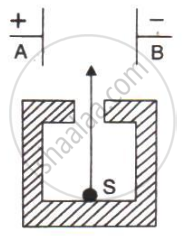Advertisements
Advertisements
Question
Arrange the α, β, and γ raditions in ascending order of their ionising powers.
Solution
Ionising power of α particles is the most and of γ-radiations the least i.e. Ionising power.
α > β > (a) γ < β < γ
α-10000 times γ and 100 times β
APPEARS IN
RELATED QUESTIONS
In following Figure shows a mixed source R of alpha and beta particles in a thick lead walled container. The particles pass through a magnetic field in a direction perpendicular to the plane of paper inwards as shown by ×.
- Show in the diagram how the particles get affected.
- Name the law used in part (a).

[Hint: Alpha particles will deflect to the left while beta particles to the right]
In following Figure shows a radioactive source S in a thick lead walled container having a narrow opening. The radiations pass through an electric field between the plates A and B.

- Complete the diagram to show the paths of α, β and γ radiations.
- Why is the source S kept in a thick lead walled container with a narrow opening?
- Name the radiation which is unaffected by the electrostatic field.
- Which radiation is defleced the most. Given reason.
- Which among the three radiations causes the least biological damage?
Explain why alpha and beta particles are deflected in an electric or a magnetic field, but gamma rays are not deflected in such a field.
State the speed of each of α, β and γ radiations.
What is the composition of α, β and γ radiations?
A radioactive substance emits radiations ______.
Compare the ionising powers of α, β and γ radiations.
The figure shows a radioactive source S placed in a thick-walled lead container. The radiations given off pass through a magnetic field acting in direction perpendicular to the plane of paper inwards as shown by X. Copy the diagram and show the path of radiations. Explain why the source is kept in a thick-walled lead container.
A beam of α, β and γ rays is travelling through a certain region in space.
- Arrange them in ascending order of ionising power.
- Which of the above will pass undeviated if subjected to an electric field?
- With respect to your answer to part (b) above, what will be the change in the nucleus of an atom after such a ray is emitted.
Which nuclear radiation will travel undeviated in an electric field?
